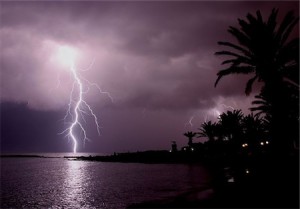
By: Luan Zuccarello
I was down the shore last weekend and watched one hell of a storm over the ocean. The lightning strikes on the water looked like something out of a Michael Bay movie. OK, maybe I had a couple beers in me and I am over exaggerating a little – but it was still cool. So I started to try and think back to 7th grade science class and to what causes lightning. However I was too interested in little Molly’s short skirt then protons and electrons (although I did get an A on “her”anus). Thank God for Google.
Lightning is a discharge of atmospheric electricity which is triggered when differing charges meet in the cloud. Typically, the bottom of a cloud is negatively charged, and it sends out what is known as a “leader” which seeks a positive charge at the top of the cloud. When these two charges meet a bolt of lightning is born. After the lightning travels to the ground or another cloud, it may strike again several times within a fraction of a second. These re-strikes are so fast that people cannot register them with the naked eye; instead, they appear as a single strike. The air near a lightning strike is hotter than the surface of the sun! The rapid heating and cooling of the air near the lightning channel causes a shock wave that results in thunder.
Here is a fun fact if you catch yourself in a storm with a baby girl. Watch for a strike of lightning then count the seconds until you hear a clap of thunder. Take this number and divide by 5. This will leave you with the number of miles the storm is away. This can provide very useful if you find yourself with a Butterface (everything looks good but her face). Now you can calculate how much longer you have to stare at her before the lights go out. Much easier and better for the girl’s self esteem then the paper bag.
